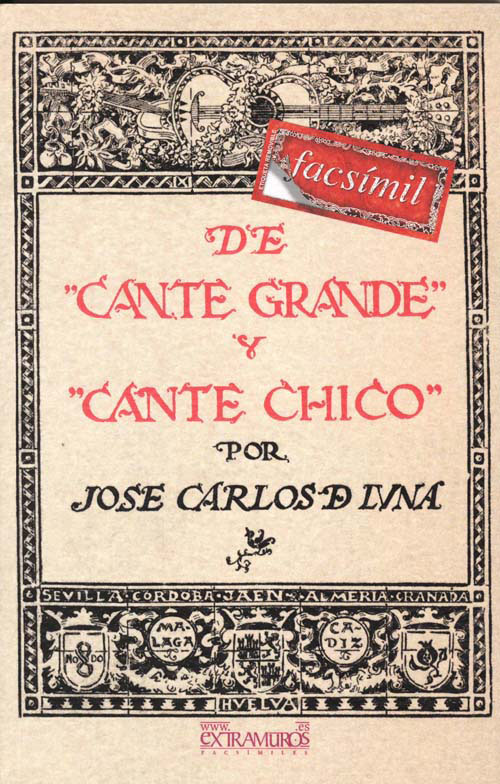- 🚚 📦 WORLDWIDE SHIPPING ✈️ 🌍
The current facsimile collects the first edition of the well known work of 1926 "De cante grande y de cante chico" by José Carlos de Luna, industrial ingineer, Civil governor of Badajoz and Seville, collaborator of many national newspapers and, above all, a "costumbrista" poet, one of the most well-read and recited poets in castellano.
Then he excelled at flamencology with works such as "El Cristo de los Gitanos" or "Café de Chinitas", and he became really popular with his poem "El Piyayo". He also was famous as a researcher with his work "Historia de Gibraltar".
"The scenes and descriptions make up a complete exhibition of the Andalusian life, in the fresh air, in the road, driving the treshing machine, looking at the Easter processions, near the crib, forging, in a tablao, in the mountains, in the country house, in the patio, during the grape harvest, in the mountainous regions and in the depth of the mine." The aim of the author with the work "De cante grande y de cante chico" is " to instil a little bit of affection and respect" for the song flamenco. Therefore he develops a mentionned compilation about songs or poems, some written by his own and some by other authors. He gives a special place to the peteneras, soleares, seguirillas, saetas, martinetes, fandangos and sevillanas.
Technical data of the facsimile
Collection: Flamenco and Andalusian folklore
ISBN: 978-84-9862-085-6
Code: E04-00044
Format: 130 X 200
Pages: 130 (b/n)
Original work
Printer: Talleres Voluntad
Place of impression: Madrid
Year of edition: 1926
Language: Spanish
The current facsimile collects the first edition of the well known work of 1926 "De cante grande y de cante chico" by José Carlos de Luna, industrial ingineer, Civil governor of Badajoz and Seville, collaborator of many national newspapers and, above all, a "costumbrista" poet, one of the most well-read and recited poets in castellano.
Then he excelled at flamencology with works such as "El Cristo de los Gitanos" or "Café de Chinitas", and he became really popular with his poem "El Piyayo". He also was famous as a researcher with his work "Historia de Gibraltar".
"The scenes and descriptions make up a complete exhibition of the Andalusian life, in the fresh air, in the road, driving the treshing machine, looking at the Easter processions, near the crib, forging, in a tablao, in the mountains, in the country house, in the patio, during the grape harvest, in the mountainous regions and in the depth of the mine." The aim of the author with the work "De cante grande y de cante chico" is " to instil a little bit of affection and respect" for the song flamenco. Therefore he develops a mentionned compilation about songs or poems, some written by his own and some by other authors. He gives a special place to the peteneras, soleares, seguirillas, saetas, martinetes, fandangos and sevillanas.
Technical data of the facsimile
Collection: Flamenco and Andalusian folklore
ISBN: 978-84-9862-085-6
Code: E04-00044
Format: 130 X 200
Pages: 130 (b/n)
Original work
Printer: Talleres Voluntad
Place of impression: Madrid
Year of edition: 1926
Language: Spanish












